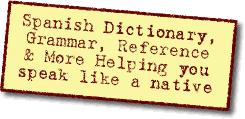Quote:
Originally Posted by sunny838

How do you say in spanish "The best has happened to me. Or I don't know what is good"?
Would it be "El (requires neuter gender agreement) mejor se *** (missing object pronoun) ocurrió. *** (Missing punctuation) O no sE (spelling/accent mark) que (either spelling or incorrect form of relative pronoun) es bueno"?
|
This is a good attempt, although there are a few things to fix.
The edit window has a drop-down list labeled "Accents" that you can use to insert accented characters and Spanish punctuation characters.
Things to consider:
1. "El/la mejor" means "the best one" (a specific thing), and not "the best" (an abstract concept). The usual way to use an adjective ("mejor" = "better" or "best) as an abstract noun ("the best") is to make it a neuter noun by using the neuter definite article "lo": "lo mejor" = "the best", "lo bueno" = "that which is good", "lo malo" = "that which is bad", "lo peor" = "the worst".
2. "se ocurrió" = "(has) happened", but where is the "to me"?
3. Initial question marks and exclamation points are mandatory.
4. "se" (no accent mark) is an object pronoun: as written the question looks like it has no verb.
5. "que" (no accent mark) = "that" (relative pronoun), not "what?" (interrogative pronoun). If you really want to use a relative pronoun in this sentence, "que" is the wrong one: you would need to use the appropriate gender/number of "el que", and in this case you would use neuter gender.


 Similar Threads
Similar Threads







